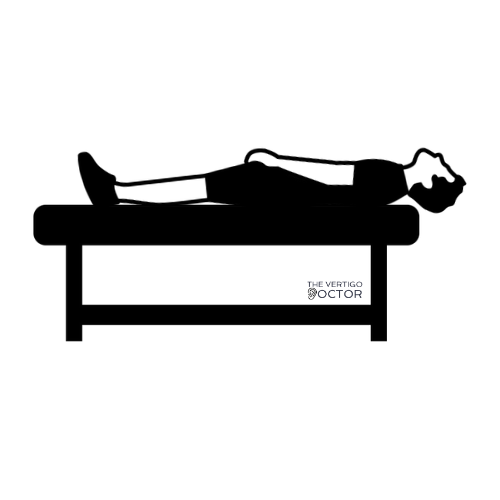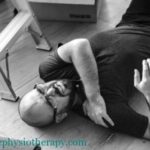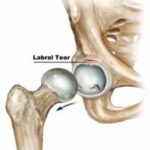Benign Paroxysmal Positional Vertigo
What is Benign Paroxysmal Positional Vertigo?
Benign Paroxysmal Positional Vertigo, typically abbreviated BPPV, is the most common cause of true spinning vertigo (1). BPPV is defined by episodic vertigo lasting 10-30 seconds and is evoked by specific head positions. BPPV occurs when tiny calcium-carbonate crystals, otoconia, become dislodged from one place in your inner ear and end up in your semicircular canals. [In order to picture this, go back to the lesson on ear anatomy!] This causes a vertigo event that people describe as room spinning, or walls sliding. People with dizziness tend to refer to all kinds of dizziness as “vertigo”, but true room spinning vertigo is most often BPPV, not other kinds of dizziness. Benign Paroxysmal Positional Vertigo is a long name, but the name really spells out what it is.
- Benign: meaning being not harmful in effect
- Paroxysmal: meaning a sudden attack
- Positional: occurring in specific positions
- Vertigo: spinning dizziness sensation
When you turn your head into certain positions, typically laying down at night to go to sleep, rolling over in bed, or looking up into a cabinet, the otoconia move inappropriately within the semicircular canals where they do not belong and cause repetitive, uncontrolled eye movements, called nystagmus. The nystagmus is what causes the room to look as though it’s spinning, and is easily treatable when your physical therapist or other provider gives you your diagnosis.
Symptoms & Diagnosis
Symptoms of Benign Paroxysmal Positional Vertigo are true room spinning/vertigo in certain positions lasting less than 1 minute, sometimes associated with nausea and vomiting. BPPV is frequently misdiagnosed in those who have other types of vertigo or experience chronic dizziness lasting longer than 1 minute.
To diagnose BPPV, your clinician will first take a thorough history. The history of your dizziness is very important as it usually becomes clear if you have BPPV, or another kind of vertigo, through questioning. Then, if your physical therapist believes you have BPPV from your history, he or she will perform a Dix Hallpike Maneuver and/or a Supine Head Turn Test.
- A Dix Hallpike maneuver is a test for Posterior Canal Canalithiasis. For this test, you will sit on the PT table, you will turn your head 45° to the left or the right, lay back quickly, and let your head extend down off of the table. Your PT should be behind you to catch your head or help you hold your head in the front. It is important you leave your eyes open so that your PT can see the nystagmus in your eyes, this will tell them which canal the otoconia have slipped into, and exactly how to treat you. If this test is positive, your PT will perform an Epley Maneuver, and if it is negative, you will test the other side by following the same steps but with your head facing the other way.
- A Supine Head Turn Test is performed for Horizontal Canal Canalithiasis. It is the same concept as Posterior Canal Canalithiasis, but the otoconia have slipped into a different semicircular canal.
- Lay on your back and let the PT hold your head in a flexed (chin tucked) position.
- Your PT will help you quickly turn your head right while maintaining the flexed position.
- Repeat to the left.
- Keep your eyes open so your PT can see your nystagmus and can best figure out what treatment you need.
Vertigo lasting longer than 2 minutes, or those who do not have consistently evoked symptoms with positional changes, should seek an alternative diagnosis (1).
Treatment of Benign Paroxysmal Positional Vertigo
Treating BPPV is highly effective and relatively simple. To treat BPPV we use Canalith Repositioning Maneuvers; the intent is to move the otoconia from the semicircular canals back to the utricle where they belong. For Posterior Canal Canalithiasis this maneuver is called the Epley Maneuver, and for Horizontal Canal Canalithiasis it is called the Lempert Maneuver or, more commonly, the Bar-B-Que roll. When done properly, these treatments have approximately a 90% success rate of eliminating symptoms in 1-2 treatments (1). I recommend doing this with a physical therapist, instead of on your own, to ensure proper clearance and avoid otoconia going into another canal.

Frequently, patients are prescribed Meclizine by their physician for dizziness associated with BPPV. Meclizine acts as a vestibular suppressant and likely will not heal you, it will just mask the sensation of being dizzy for a short period of time. That being said, it can sometimes be helpful during your Canalith Repositioning Maneuver treatment. Anecdotally, when patients are prescribed this drug, their doctors have recommended they take it if they are especially sensitive to the Canalith Repositioning Maneuver. Discuss this option with your qualified healthcare provider if you think this might be the right avenue for you!
If your PT performs a Dix Hallpike Maneuver and determines you have upbeat torsional nystagmus you will then be treated with an Epley Maneuver. This is what to expect when treating a right Posterior Canal Canalithiasis with an Epley Maneuver:
- Your PT will help you perform a Dix Hallpike: turn your head 45° to the right, lay down quickly, and extend your head off the table.
- After your symptoms pass and 20 seconds are added, your PT will roll your head all the way over to the left while maintaining your head in extension. Wait 20 seconds after symptoms pass to move to Step 3.
- Continue your roll to the left by rolling onto your shoulder, facing your head toward the ground, and then tucking your chin toward your chest.
- Next, you will sit up keeping your chin tucked, this is typically easiest when you slide your legs off the side of the table and use your arms to press yourself up so you’re sitting on the edge of the table. Sit with your chin tucked for about 15 seconds
The above steps should clear your BPPV when performed with a physical therapist or other healthcare providers. Although many people choose to perform this at home, I find that trying to treat the Posterior Canal patients frequently causes the otoconia to go into the Horizontal Canal, and therefore do not usually recommend this as an at-home treatment.
If your PT performs a Supine Roll Test and sees you have geotropic nystagmus, your PT may determine you have Horizontal Canal Canalithiasis. For this, you will perform a Bar-B-Que Roll. Here is what to expect for the right Bar-B-Que roll:
- You will begin on your back with your chin flexed up toward your chest about 20°.
- Quickly turn your head toward the left (unaffected) side 90°. Hold this position for 30-60 seconds.
- Roll to the left onto your stomach propped on your elbows so your head is hanging down toward the floor slightly, maintaining the 20° of flexion. Hold for 30-60 seconds.
- Continuing to roll left, roll onto your right shoulder, slide your legs off the side of the table, and sit up. Keep your chin tucked for about 30 seconds.
The above steps should clear your Horizontal Canal BPPV. This maneuver often causes nausea, you can be prepared with common solutions for nausea like ginger, mint gum, sparkling water, or another solution you use when you feel nauseous. Although treatment for BPPV will likely reproduce your symptoms during treatment, it tends to be a simple fix and is often treated in just 1-2 sessions with your PT.
Physical Therapy
Physical therapists are one of the main providers who perform Canalith Repositioning Maneuvers, so with BPPV, physical therapists are vital to your treatment! If you are pretty sure this is what’s going on, make an appointment with a vestibular PT today. He or she will evaluate you completely, determine the canal and source of your dizziness, and treat you accordingly!
Source:
(1) Fife, T. D. (2017). Dizziness in the Outpatient Care Setting. CONTINUUM: Lifelong Learning in Neurology, 23(2), 359-395. doi:10.1212/con.0000000000000450. https://journals.lww.com/continuum/Fulltext/2017/04000/Dizziness_in_the_Outpatient_Care_Setting.7.aspx











